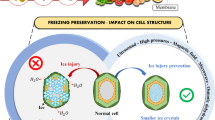Summary
Microtubers can be stored longer, transported and handled easier than plantlets, but they have some disadvantages related to long dormancy. Dormancy, number of sprouts per tuber and loss of microtubers under different storage temperatures were studied. Microtubers of four genotypes originated from different tuberization treatments (photoperiod combinations) were observed. We found that dormancy depended on cultivar and — in some cases — on the photoperiod treatment applied during tuberization. Generally, the dormacy was long and was greatly elongated by low storage temperature. One of the photoperiod treatments shortened while the other treatment prolonged the rest-period compared to the control, maybe due to a change in temperature accompanying the change in daily light (photoperiod combination). Besides, these treatments affected the number of sprouts per tuber. There was no significant difference in duration of dormancy between different tuber-size groups, but the loss increased significanctly with a decrease in tuber size. Based on this information we can use microtubers more effectively in the seed potato production programme.
Similar content being viewed by others
References
Bottini, G.A., R. Bottini & R. Tizio, 1982. Physiology of dormancy in potato tubers as related to levels of endogenous regulators.Phyton 42 (1): 115–121.
Copeland, R.B., 1990. Yield and disease in progeny of field-grown mini- and microtubers. Proceedings 11th Triennial Conference EAPR Edinburgh, pp. 450–451.
Dobránszki, J., 1996. Effects of dark treatment on tuber initiation and development of induced potato plantets cultured in vitro.Acta Agronomica Hungarica 44 (4): 377–386.
Garner, N. & J. Blacke, 1989. The induction and development of potato microtubers in vitro on media free of growth regulating substances.Annals of Botany 63: 663–674.
Ittersum, M.K. van, 1992. Variation in the duration of tuber dormancy within a seed potato lot.Potato Research 35: 261–269.
Kumar, G.N.M. & R. Knowles, 1993. Involvement of auxin in the loss of apical dominance and plant growth potential accompanying aging of potato seed tubers.Canadian Journal of Botany 71: 541–550.
Leclerc, Y., D.J. Donnelly, W.K. Coleman & R.R. King, 1995. Microtuber dormancy in three potato cultivars.American Potato Journal 72: 215–223.
Lommen, W.J.M., 1993. Post harvest characteristics of potato minitubers with different fresh weights and from different harvests. II. Losses during storage.Potato Research 36: 273–282.
Lommen, W.J.M. & P.C. Struik, 1990. Dormancy and vigour of minitubers after storage periods of different length. Abstract of Conference Papers 11th Triennial Conference EAPR, Edinburgh, pp. 448–449.
Ortiz-Montiel, G. & H. Lozoya-Saldana, 1987. Potato minitubers: technology validation in Mexico.American Potato Journal 64: 535–544.
Ranalli, P., M. Bizarri, L. Borghi & M. Mari, 1994. Genotypic influence on in vitro induction dormancy length, advancing age and agronomical performance of potato microtubers (Solanum tuberosum L.).Annals of Applied Biology 125: 161–172.
Rosell, G., F.G. De Bertoldi & R. Tizio, 1987. In vitro mass tuberisation as a contribution to potato micropropagation.Potato Research 30: 111–116.
Struik, P.C. & W.J.M. Lommen, 1991. Production, storage and use of micro-and minitubers. Proceedings 11th Triennial Conference EAPR, Edinburgh, pp. 122–133.
Suttle, J.C. & J.F. Hultsrand, 1994. Role of endogenous abscisic acid in potato microtuber dormancy.Plant Physiology 105: 891–896.
Tovar, P., R. Estrada, L. Schilde-Rentschler & J.H. Dodds, 1985. Induction and use of in vitro potato tubers.CIP Circular 13: 1–5.
Wiersema, S.G., R. Cabello, P. Tovar & J.H. Dodds, 1987. Rapid seed multiplication by planting into beds microtubers and in vitro plants.Potato Research 30: 117–120.
Author information
Authors and Affiliations
Rights and permissions
About this article
Cite this article
Tábori, K.M., Dobránszki, J. & Ferenczy, A. Some sprouting characteristics of microtubers. Potato Res 42, 611–617 (1999). https://doi.org/10.1007/BF02358179
Issue Date:
DOI: https://doi.org/10.1007/BF02358179




